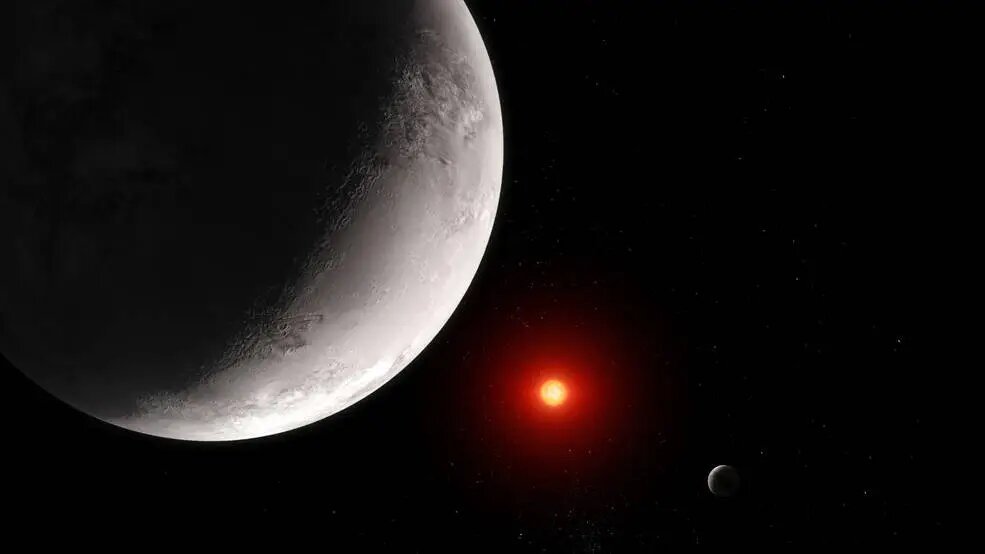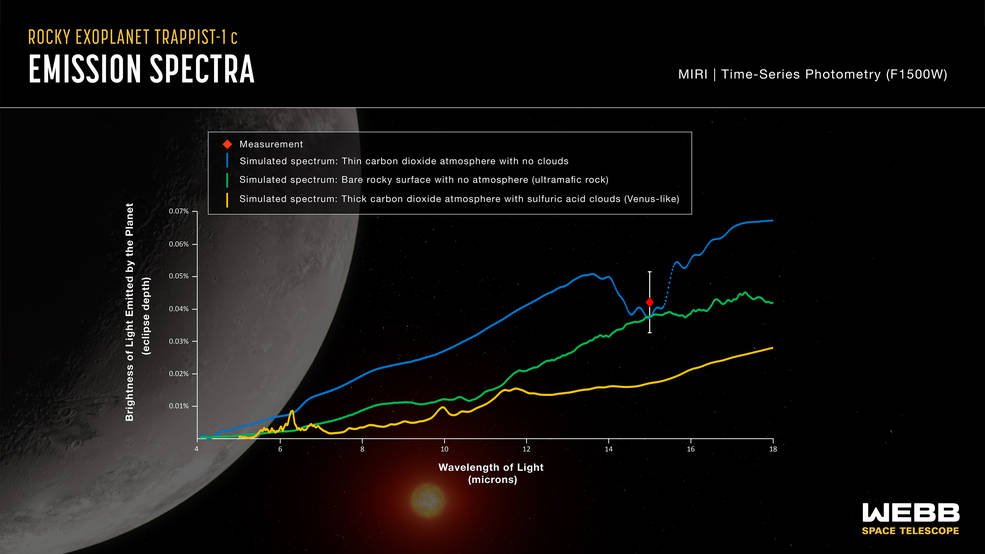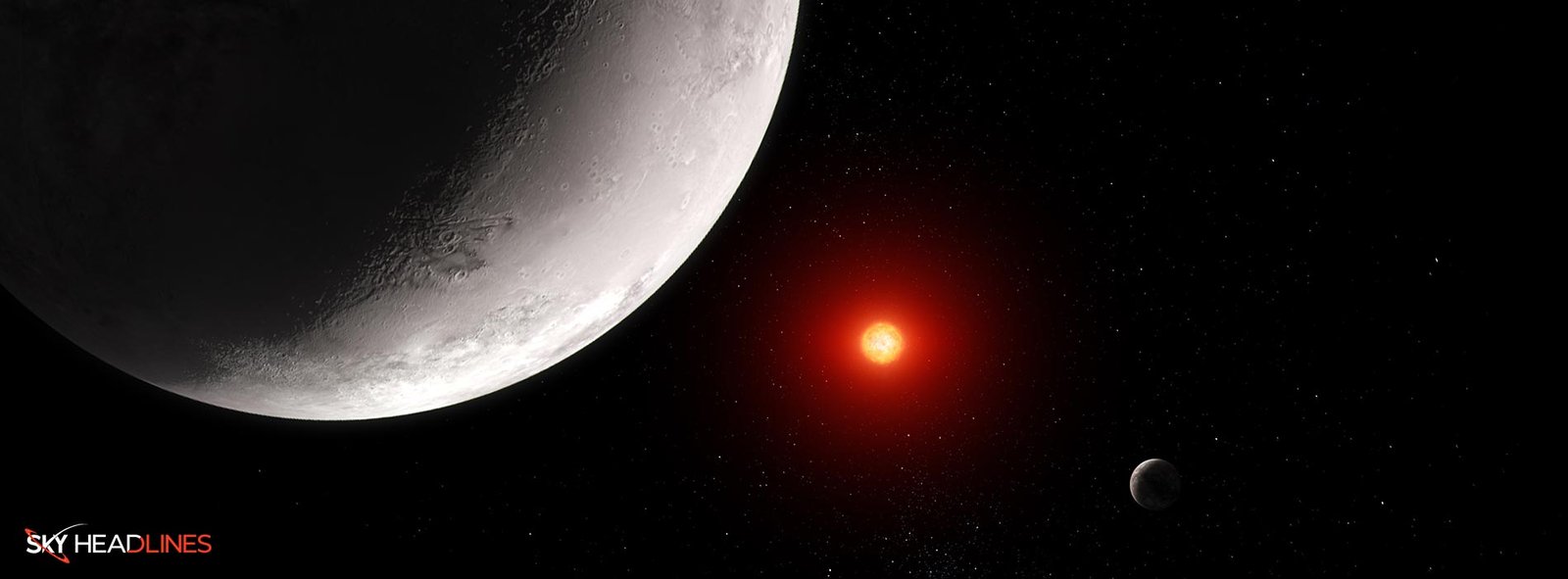TRAPPIST-1 c Atmosphere’s Analysis
A team of scientists from around the world used NASA’s James Webb Space Telescope to calculate the amount of heat energy emitted by TRAPPIST-1 c, a rocky exoplanet. The findings indicate that, if there is indeed an atmosphere, it is remarkably tenuous.

Credits: NASA, ESA, CSA, Joseph Olmsted (STScI)
TRAPPIST-1 c, with a dayside temperature of approximately 380 kelvins, currently holds the record for being the coolest rocky exoplanet characterized by thermal emission. The accuracy required for these measurements showcases the effectiveness of the Webb telescope in analyzing rocky exoplanets similar in size and temperature to those within our solar system.
The recent breakthrough in research marks a momentous stride in unraveling the mystery of whether planets circling diminutive red dwarfs such as TRAPPIST-1, the most abundant kind of stars in our galaxy, can sustain life-sustaining atmospheres akin to what we recognize.
Clues to Atmospheric Composition
Sebastian Zieba, a graduate student at the Max Planck Institute for Astronomy in Germany and the lead author of the published results in Nature, stated, “We want to know if rocky planets have atmospheres or not. In the past, we could only really study planets with thick, hydrogen-rich atmospheres. With Webb, we can finally start to search for atmospheres dominated by oxygen, nitrogen, and carbon dioxide.”
TRAPPIST-1 c is one of seven rocky planets orbiting an ultracool red dwarf star, approximately 40 light-years away from Earth. The presence of similar size and mass notwithstanding, the question of whether these planets possess atmospheres akin to the inner rocky planets in our solar system remains shrouded in uncertainty. During the initial billion years of their existence, M dwarfs emit intense X-ray and ultraviolet radiation capable of stripping away a young planetary atmosphere. In addition, it’s possible that not enough water, carbon dioxide, or other volatile chemicals were present during the planets’ creation to support significant atmospheres.
TRAPPIST- 1 c, the Venus Twin
Laura Kreidberg, also from Max Planck and a co-author, explained, “TRAPPIST-1 c is interesting because it’s essentially a twin of Venus: it shares a similar size and receives a comparable amount of radiation from its host star as Venus does from the Sun. We speculated that it could possess a dense carbon dioxide atmosphere akin to Venus.”
To address these inquiries, the team employed Webb’s Mid-Infrared Instrument (MIRI) to observe the TRAPPIST-1 system on four separate occasions as the planet passed behind the star, resulting in a secondary eclipse. The team determined the amount of mid-infrared light, specifically at 15 microns, emitted by the planet’s dayside by comparing the brightness when the planet is beside the star (combining light from the star and planet) with the brightness when the planet is behind the star (representing only starlight).

Credits: NASA, ESA, CSA, Joseph Olmsted (STScI)
This methodology mirrors the approach employed by another research group to determine that TRAPPIST-1 b, the innermost planet in the system, likely lacks any atmosphere. A planet’s amount of mid-infrared radiation is strongly related to its temperature, which is determined by the composition of its atmosphere. Carbon dioxide gas selectively absorbs 15-micron light, causing the planet to appear dimmer at that wavelength. However, clouds can reflect light, making the planet appear brighter and concealing the presence of carbon dioxide.
Furthermore, a substantial atmosphere of any composition would redistribute heat from the dayside to the nightside, resulting in a lower dayside temperature than would be observed without an atmosphere. TRAPPIST-1 c is thought to be tidally locked, with one side always in the light and the other always in the dark, as it orbits its star nearby (about 1/50th the distance between Venus and the Sun).
TRAPPIST- 1 c’s Carbon Dioxide Cover
Although these initial measurements do not provide definitive information about the nature of TRAPPIST-1 c, they help narrow down the potential possibilities. Zieba noted, “Our results are consistent with the planet being a barren rock with no atmosphere, or the planet possessing an extremely thin CO2 atmosphere (thinner than Earth or even Mars) devoid of clouds. If the planet had a thick CO2 atmosphere, we would have observed a very shallow secondary eclipse or none at all. This is because the CO2 would absorb all the 15-micron light, and we wouldn’t detect any coming from the planet.”
Moreover, the data suggest that TRAPPIST-1 c is unlikely to be a true Venus analog with a thick CO2 atmosphere and sulfuric acid clouds.
Habitable Atmospheres In TRAPPIST-1
The absence of a dense atmosphere implies that the planet may have formed with minimal water. If the other cooler, temperate TRAPPIST-1 planets formed under similar conditions, they might also have started with limited amounts of water and other essential components required for a habitable planet.
The sensitivity required to differentiate between various atmospheric scenarios on such a distant and small planet is genuinely remarkable. The decrease in brightness detected by Webb during the secondary eclipse was merely 0.04 percent, akin to observing a display of 10,000 small light bulbs and noticing that only four have extinguished.

Kreidberg expressed her awe, stating, “It is extraordinary that we can measure this. There have been questions for decades now about whether rocky planets can retain atmospheres. Webb’s capabilities truly allow us to compare exoplanet systems to our solar system in a way we have never been able to before.”
Web Telescope Insights
This research was conducted as part of Webb’s General Observers (GO) program 2304, one of the eight programs dedicated to fully characterizing the TRAPPIST-1 system during Webb’s first year of scientific operations. The full orbits of TRAPPIST-1 b and TRAPPIST-1 c will be observed in a follow-up examination in the future year, according to researchers. They will be able to track temperature fluctuations on the day and night sides of the two planets, which will provide them with more information about the existence or lack of atmospheres.





